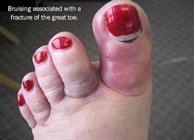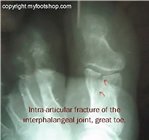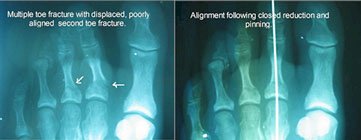- Summary
- Symptoms
- Read More
Summary

A broken toe can happen to any of the toes, but a broken 5th toe is by far the most common. The terms broken toe and fractured toe are used synonymously. Fractures of the lesser toes usually occur in a spiral oblique manner, meaning the bone breaks and spirals through the base of the toe (proximal phalanx.) Fractures can also result from impaction or crushing force. Crush fractures are more common on the great toe.
Symptoms
Bruising very common with digital fractures
Edema (swelling) of the digit with hours of the fracture
Alignment of the toe may be straight or mal-aligned
Difficulty getting into shoes due to pain
Description
 The fifth or little toe is the most common site for digital fractures. These fractures usually occur in a spiral oblique manner, meaning that the bone breaks and the break spirals through the proximal phalanx. Bruising occurs because of a crack in the outer cortex of the bone. This crack leads to bleeding in an enclosed space adjacent to the skin. Fractures also can result from impaction or crushing force. Broken toes cannot be differentiated from sprained toes without an x-ray. As a general rule, toe injuries with significant bruising are fractures.
The fifth or little toe is the most common site for digital fractures. These fractures usually occur in a spiral oblique manner, meaning that the bone breaks and the break spirals through the proximal phalanx. Bruising occurs because of a crack in the outer cortex of the bone. This crack leads to bleeding in an enclosed space adjacent to the skin. Fractures also can result from impaction or crushing force. Broken toes cannot be differentiated from sprained toes without an x-ray. As a general rule, toe injuries with significant bruising are fractures.
Dislocation of the toes is uncommon. When dislocation of the toe(s) does occur, it is typically due to the toe being caught (fixed) as the body weight continues. As an example, think of crossing a baby gate while barefoot, catching the toe in the gate and falling.
Causes and Contributing Factors
The mechanism of injury in a spiral oblique digital fracture is unique. When the fifth toe comes in contact with a fixed object such as the bedpost, the base of the proximal phalanx is held firm by the ligaments of the metatarsal phalangeal joint. Continued force generates a bending to the proximal phalanx. As the bone fatigues, it fractures in a very predictable oblique pattern.
Treatment
Treatment of broken toes follows some basic principals of fracture care. An x-ray is indicated to ensure proper alignment of the fracture and apposition of the fracture fragments. Without good alignment and apposition, the fracture will not only take longer to heal but may heal in poor alignment, resulting in a crooked toe. Without an X-ray, it's just a guess as to whether the alignment and apposition of the fracture fragments are correct. An X-ray also confirms whether the fracture extends into a joint. Fractures that extend into a joint will not only take longer to heal but may cause a higher incidence of arthritis in that joint in years to come.
will not only take longer to heal but may heal in poor alignment, resulting in a crooked toe. Without an X-ray, it's just a guess as to whether the alignment and apposition of the fracture fragments are correct. An X-ray also confirms whether the fracture extends into a joint. Fractures that extend into a joint will not only take longer to heal but may cause a higher incidence of arthritis in that joint in years to come.
In all cases, rest, ice, and elevation are important. Rest and elevation will enable the body to begin the natural process of healing. Ice is a simple way to mediate the natural inflammatory response post-fracture.
Wrapping the fractured toe with Co-Flex (CoBan) will help to stabilize the toe and compress swelling. Co-Flex is used to wrap the toe in a cylindrical manner almost like a little cast. In this way, the fracture is not only splinted, but swelling is also controlled. Co-Flex can be reused so that a little strip can last several days. Other splinting alternatives include a toe straightener, toe loops, or buddy splinting with Co-Flex. Lastly, fracture shoes also are helpful to allow for ambulation while offering enough room for the fractured toe.
Some digital fractures will require surgical care. Realignment can usually be accomplished through closed reduction with or without pin fixation. Closed reduction means that the fracture is realigned with the patient under anesthesia but without an open incision. If fixation is used, pins remain in the fracture for a period of two to six weeks post-closed reduction.
reduction with or without pin fixation. Closed reduction means that the fracture is realigned with the patient under anesthesia but without an open incision. If fixation is used, pins remain in the fracture for a period of two to six weeks post-closed reduction.
Fractured toes may take up to 10 weeks to heal depending on the apposition and alignment, severity of the fracture, and the patient's overall ability to heal.
Differential Diagnosis
The differential diagnosis for a broken toe includes:
Dislocated toe
Freiberg's infraction
Gout
Hallux limitus
Hallux rigidus
Metatarsal fracture
Sesamoid fracture
Turf toe
When to contact your doctor
Toe injuries with a suspected fracture should be evaluated by your podiatrist or orthopedist for appropriate care.
References
References are pending.
Author(s) and date
![]() This article was written by Myfootshop.com medical advisor Jeffrey A. Oster, DPM.
This article was written by Myfootshop.com medical advisor Jeffrey A. Oster, DPM.
Competing Interests - None.
Cite this article as - Oster, Jeffrey. Broken Toe. https://www.myfootshop.com/article/broken-toe
Most recent article update - November 10, 2020.
 Broken Toe by Myfootshop.com is licensed under a Creative Commons Attribution-NonCommercial 3.0 Unported License.
Broken Toe by Myfootshop.com is licensed under a Creative Commons Attribution-NonCommercial 3.0 Unported License.